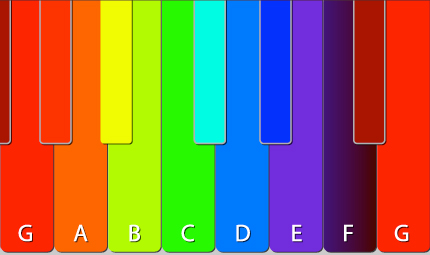


|
Sound & Colour |

|
 colour and sound copyright Nick Fiorenza |
intro Some years ago a friend asks me whether I would like to create music corresponding to the basic colours. After thinking about it, I search the web for such a relation. Finding nothing convincing, I decide to use the octave method: dividing again and again the colour frequencies by the number 2 till you get sound frequencies you can hear. I am gladly surprised finding a clear relationship. Not tone scale C, but the F-scale: red = G, orange = A, yellow = B flat etc. I decide to start with colour RED. In the track you ‘hear’ this colour as a long-continued bass sound G. Together with this sound there are sounds of nature, singing and other sounds. Recently I have completed all the other tracks: ORANGE, YELLOW, GREEN, BLUE, INDIGO and VIOLET. All with their special bass sound: A, B flat, C, D, E and F. Click here for a short video-impression. After finishing the ORANGE track, I decide to search the internet again. Surprisingly, I find two very interesting sites. First www.lunarplanner.com, from Nick Anthony Fiorenza. In life he explored the same relation between sound and colour, but the other way around: doubling sound frequencies till you get colours we are able to see. See the picture at the left, published with permission of Nick. He died in 2020. The next site was created by Roel Hollander. He mentions the results of Nick’s work, but discusses other’s as well. Go to roeljollander.eu. Somewhat later I stumble across yet two other very interesting sites: www.flutopedia.com (with a very sophisticated coloured map!), and soundslikenoise.org (with many interesting stories about the relations between colour and sound). |

|
the making of After a short time only it becomes clear to me that the choice of the special bass sound does not allow using any themes I like: the combination has to sound harmonically as much as possible. That’s no problem with sounds of nature of course. I pay much attention to the special bass sound: it should not irritate by sounding too much the same all the time. Just like the music I created earlier, the process sometimes stops for weeks. |
||
 Ria Font Freide click picture for site |
experiences Having finished a great deal of track4, I happen to meet Ria Font Freide. When I tell her about the project, she is very interested. In the end, she decides to use the first three tracks during a workshop for former students of Inner Sjamanism. At the end of each track they write their experiments on a little card. Needless to say their experiences turn out to be very different. Some students don’t make it to stay all three tracks long, others want to experience them again. | |

|
testing?
Like to test it? Go to the contact-page (link below), and send an email. Please write why and how you want to test what. With your name and emailaddress, also any questions you might have. We will respond as soon as possible. |

|